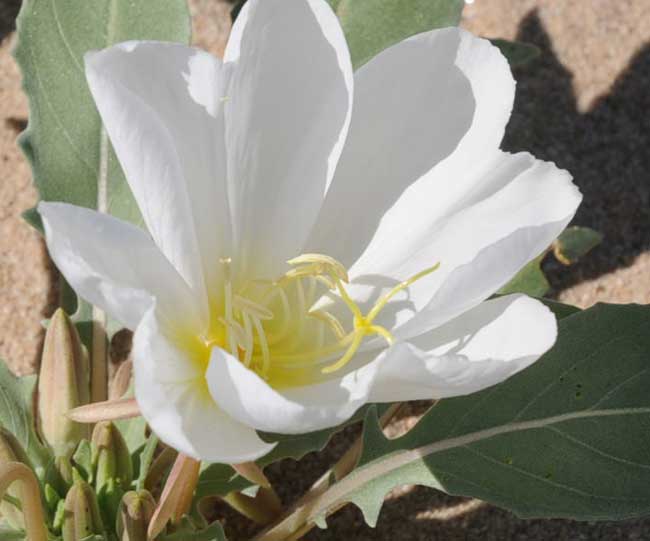^Dune evening primrose (Oenothera deltoides).
August 19, 2010 - Energy Commission Preliminary Approval >>UPDATES
Energy Commission Licenses Genesis
Energy Commission Approves 959 MW of Solar Power in California Desert
SACRAMENTO - Following the recent success of licensing solar energy facilities, the California Energy Commission today approved nearly 1,000 megawatts (MW) of solar power in Southern California.
The Genesis Solar Energy Project and the Imperial Valley Solar Project, totaling 959 MW, are now the fifth and sixth solar power plants that the Energy Commission has licensed in the past five weeks. Since late August, the Commission has licensed 2,829 MW of renewable solar power in the California desert.
"These approved solar projects continue to demonstrate the importance of harnessing the power of the sun for clean, renewable energy for California's communities," said Energy Commission Chairman Karen
Douglas. "By adding nearly 1,000 megawatts of renewable power we will reduce the consumption of fossil fuels and get the State closer to its goals of using more renewables by 2020. Today's actions show how California is leading the nation by licensing nearly 3,000 megawatts this year with large-scale solar power plants," Douglas added.
In two separate unanimous votes, the Energy Commission adopted the presiding member's proposed decisions (PMPD) that recommended licensing the 250-MW Genesis project in Riverside County and the 709-MW Imperial Valley project in Imperial County. In order to qualify for federal stimulus funds, the projects needed to be approved by the Energy Commission before December 31, 2010.
These projects are a direct result of the successful partnership between California and the Department of the Interior (DOI). In October 2009, California was the first state to sign a memo of understanding with the DOI to develop long-term renewable energy plans through state and federal permitting processes that can receive 30 percent federal tax credits under the American Reinvestment and Recovery Act. The two projects would be among the first commercial solar thermal power plants permitted on federal public land in the United States. Both projects still require decisions from the Bureau of Land Management (BLM), which approves the use of federal public lands, before they can proceed. The BLM's actions are scheduled for October.
The Genesis Solar Energy Project is being proposed by Genesis Solar LLC, a subsidiary of NextEra Energy Resources, LLC. The project site is located in eastern Riverside County about 25 miles west of Blythe. The project is north of Ford Dry Lake and Interstate 10. The project is seeking a right-of-way grant from the BLM for 4,640 acres, with construction and operation of the facility taking up about 1,800 acres.
The proposed project would use parabolic trough technology where parabolic mirrors are used to heat a transfer fluid which is then used to generate steam. Electricity is produced from the steam expanding
through steam turbine generators.
The Imperial Valley Solar Project is being developed by Imperial Valley Solar, LLC, a subsidiary of Tessera Solar, in Imperial County. The project is located about 14 miles west of El Centro.
The Genesis and Imperial Valley projects are among nine large solar thermal projects scheduled to go before the Commission before the end of the year. More than 4,100 megawatts of solar power will be added if all nine projects are approved. The nine projects would provide more than 8,000 construction jobs and more than 1,000 operational jobs.
The four previously licensed plants are: the 250-MW Beacon Solar Energy Project (Aug. 25); the 250-MW Abengoa Mojave Solar Project (Sept. 8); the 1,000-MW Blythe Solar Power Project (Sept. 15); and the 370-MW Ivanpah Solar Electric Generating System project (Sept. 22). The 663.5-MW Calico Solar Project is scheduled for the Oct. 28 meeting. Two other projects, the 500-MW Palen Solar Power Project and the 150-MW Rice Solar Energy Project, are still under review.
The PMPDs for the Genesis and Imperial Valley projects said the facilities, even with mitigation measures, will have significant impacts on cultural resources, land use, and visual resources. The Imperial Valley project also will have significant impact on biological resources and would be inconsistent with an Imperial County land use ordinance.
However, the benefits of the projects would override those impacts. The Genesis project will require a peak workforce of 1,085 during construction, with another 50 jobs when the plant is in operation. The
Imperial Valley project will need a peak workforce of 731 during construction, with another 164 operational jobs.
The PMPDs were based solely on the record of facts that were established during the facilities' certification proceedings.
The proposed solar thermal power projects that the Energy Commission is considering will help meet the state's Renewables Portfolio Standard, which requires California's electricity utility companies to use
renewable energy to produce 20 percent of their power by 2010 and 33 percent by 2020. Solar energy is a main source of renewable power.
The federal government and the State of California have established the need to increase the development and use of renewable energy in order to enhance the nation's energy independence, meet environmental goals, and create new economic growth opportunities.
Genesis Solar Project:
http://www.energy.ca.gov/sitingcases/genesis_solar/
Solar Plant Seeks Big Water Use
July 9, 2010 - NextEra Energy Resources LLC, which currently owns the Harper Lake SEGS solar thermal plants in San Bernardino County, is seeking to build a wet-cooled 250-megawatt (MW) solar thermal power plant in the Chuckwalla Valley of California.
The project is located approximately 25 miles west of the city of Blythe, California, on lands managed by the Bureau of Land Management (BLM). The project proposed for an undeveloped area of the Sonoran Desert. The McCoy Mountains lie to the east, the Palen Mountains (including the Palen/McCoy Wilderness Area) lie to the north, and Ford Dry Lake, a dry lakebed, is to the south. I-10 is located to the south of the project facility. The Chuckwalla Mountains and Little Chuckwalla Mountains Wilderness Areas are also located farther south-southwest. Ford Dry Lake was formerly open to the public for off-highway vehicle use but has since been closed.
What makes this solar project different from may others in the California desert is that NextEra wants to use wet-cooling technology instead of dry-cooling.
At a January 22, 2010 Renewable Energy Policy Group meeting, of solar companies seeking applications from the California Energy Commission (CEC), the Energy Commission warned the company that low-quality groundwater at the Genesis site presented water concerns. CEC warned NextEra that it might not permit the Genesis facility if it does not switch to dry-cooling. NextEra responded that no other method of cooling was economically viable. CEC and NextEra also disagreed about whether the groundwater was from the Colorado River groundwater basin, a determination which would have consequences for the ease of gaining access to water.
Evidentiary hearings held by CEC in Sacramento will be on July 12, 13, and 21, 2010. See the California Energy Commission website for more information.
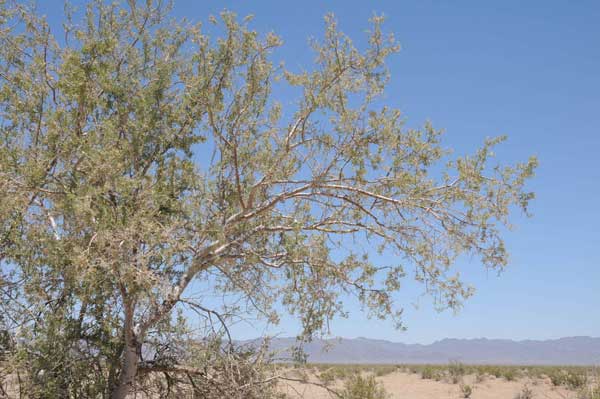
^Ironwood (Olneya tesota) on the project site, with the McCoy Mountains in the distance.

^Regional map showing the project in yellow outline just north of Highway 10 in the Chuckwalla Valley. Blythe lies to the far right.
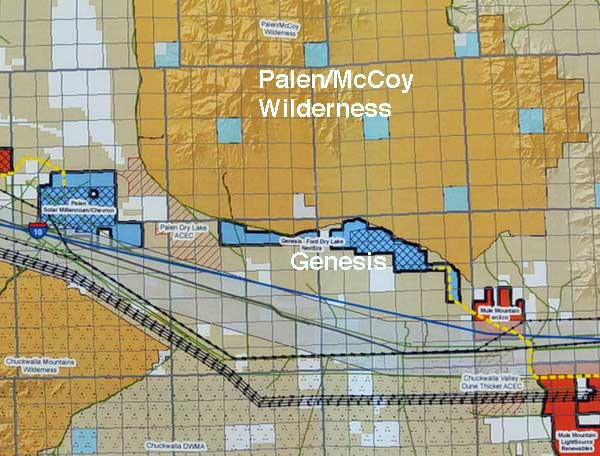
^Blue solar thermal projects: left is Palen Solar Power Project, center is Genesis Solar Energy Project.
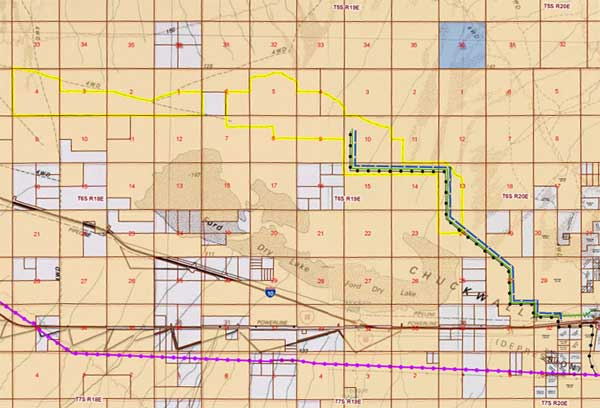
^Genesis Right-of-Way in yellow on BLM land. Blue-green lines are natural gas pipeline.

^Project footprint of the solar fields and power blocks, in the eastern part of the ROW.

^The boundary of the Palen-McCoy Wilderness lies along the project ROW.
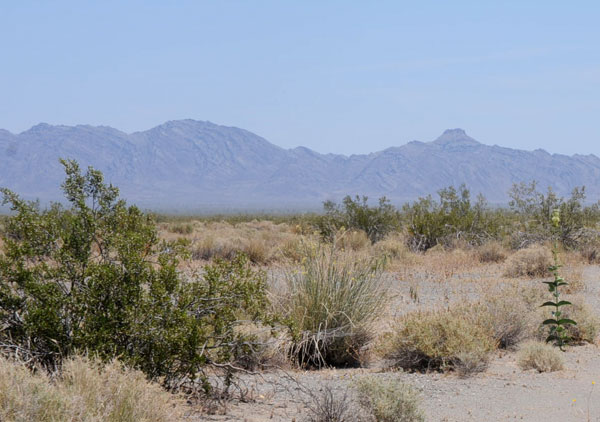
^Project site small wash with creosote, bursage, and two milkweed species: Rush milkweed (Asclepias subulata) looking like a grass bunch and Desert milkweed (A. erosa) with large leaves.
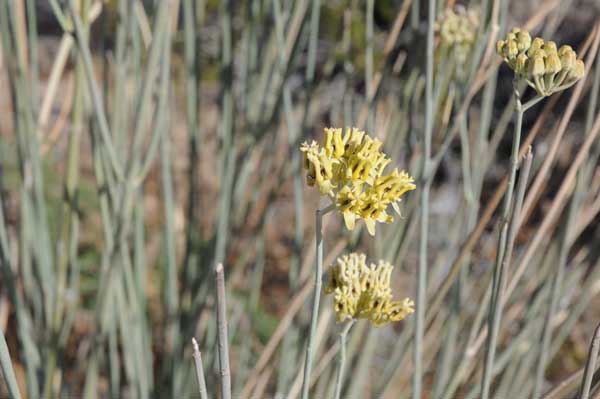
^Rush milkweed (Asclepias subulata).
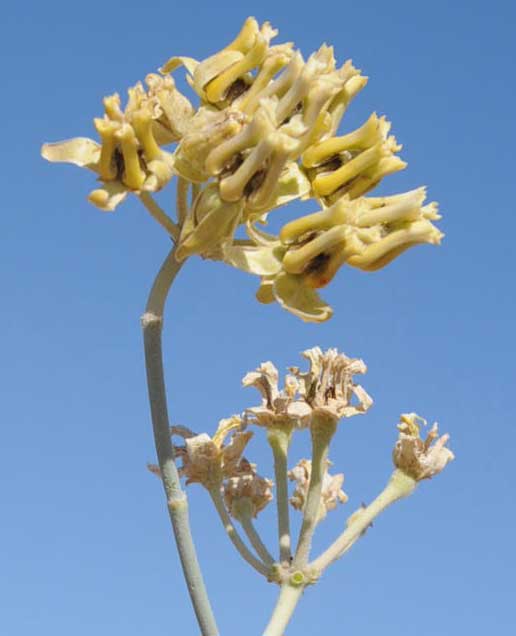
^Rush milkweed flowers.
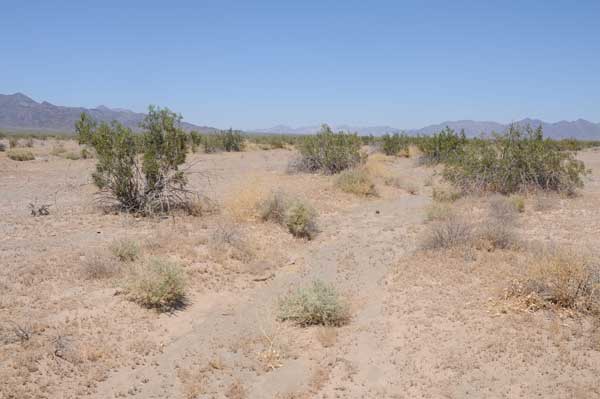
^Small wash in the project site with Bursage and Creosote. Most wildflowers have dried up in June.
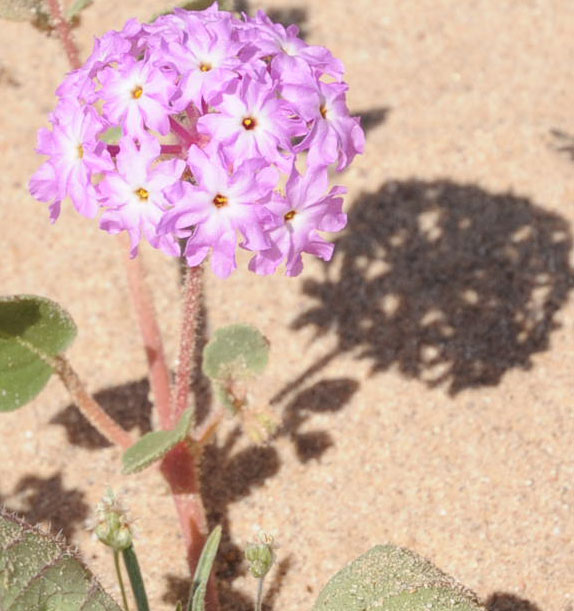
^Desert sand verbena (Abronia villosa).

^Small palo verde (Parkinsonia florida) trees in the project footprint.
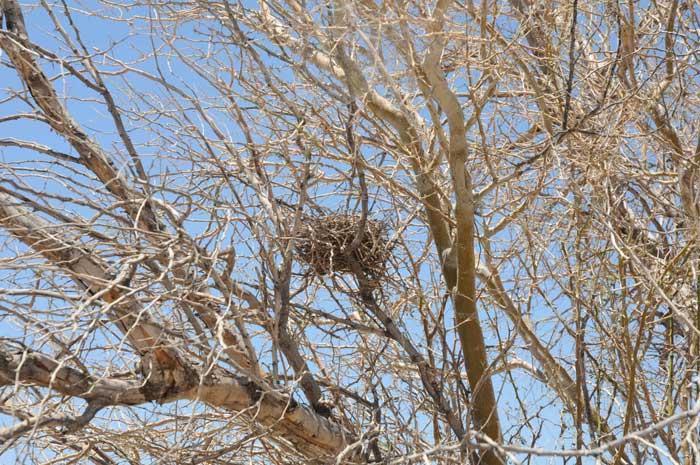
^Nest in dead Ironwood tree, probably a Loggerhead shrike (Lanius Ludovicianus). A second nest lay hidden below this one in the branches, and a shrike flew out of it.

^The well-hidden active shrike nest.
^Loggerhead shrike nest. The mother circled us about a hundred meters out, waiting for us to leave. We quickly did, and she returned about a minute later. In the picture are two chicks and three unhatched eggs. The Loggerhead Shrike is a predator, but it does not have the strong feet and talons of a raptor. It does have a strongly hooked bill for gripping flesh, and a strong notch or "tooth" near the bill tip that helps sever the spinal cord of its prey. It uses thorns and barbed wire to hold large prey while it rips it up, and may wedge prey into a fork in a branch for the same purpose. (Photo by Tom Budlong).
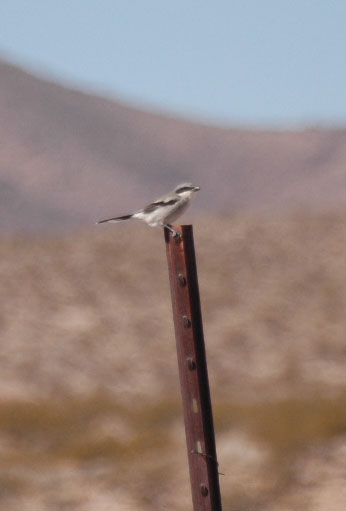
^Loggerhead shrike.
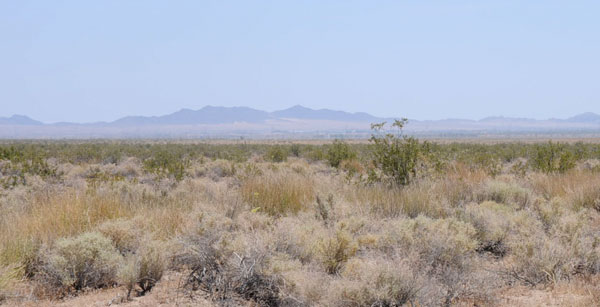
^Saltbush (Atriplex polycarpa), Creosote (Larrea tridentata), Big galleta grass (Pleuraphis rigida) community in the western part of the Right-of-Way.
^Creosote-galleta grass community (Photo by Tom Budlong).
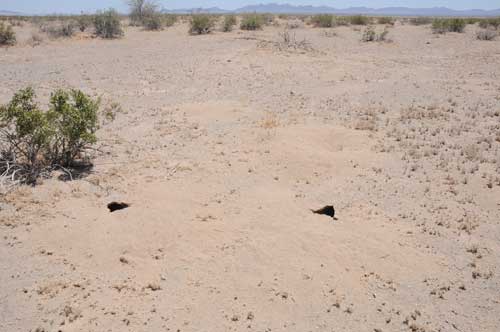
^Probable kangaroo rat (Dipodomys sp.) burrows on the project site.
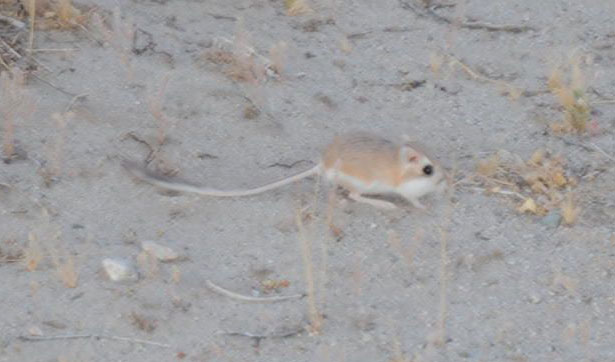
^Merriam's kangaroo rat (Dipodomys merriami) that I photographed in the early morning dusk light at the nearby Palen Solar Power Project site west of the Genesis site in Chuckwalla Valley.
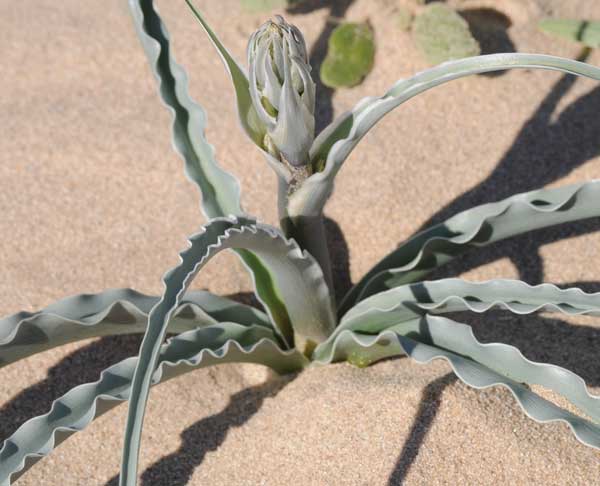
^Desert lilies (Hesperocallis undulata) emerge from bulbs in the sand in March, and begin to grow buds.
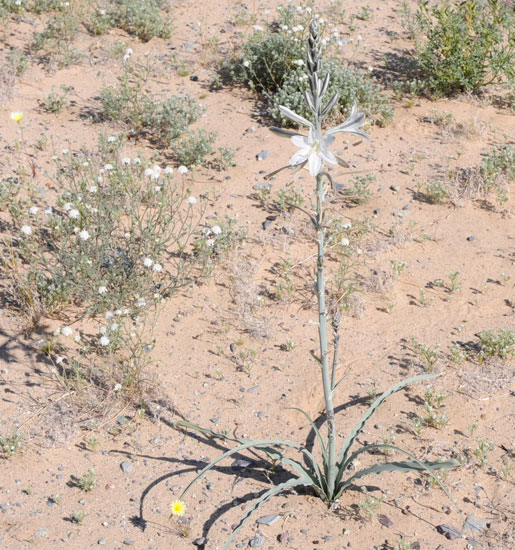
^Desert lily flowering in spring, with pincushion (Chaenactis stevioides).
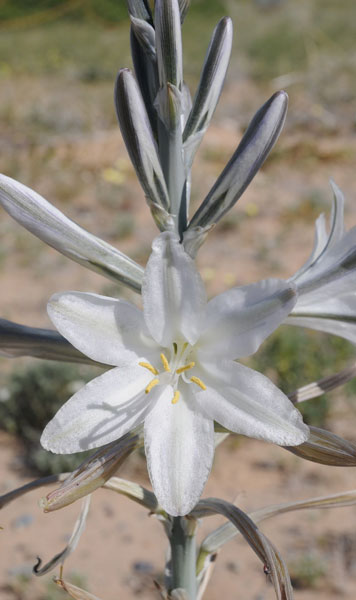
^Desert lily flower.
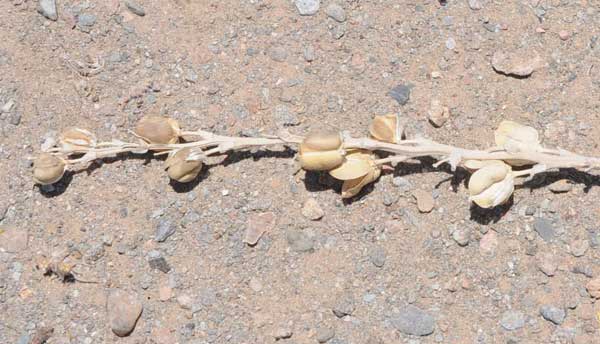
^By June the lilies have dried and the stems fallen over, releasing seeds from opened pods. On the project site.
^A small ironwood tree on the project site. (Photo by Tom Budlong)
^Last of the Desert gold (Geraea canescens) for the season (Photo by Tom Budlong).
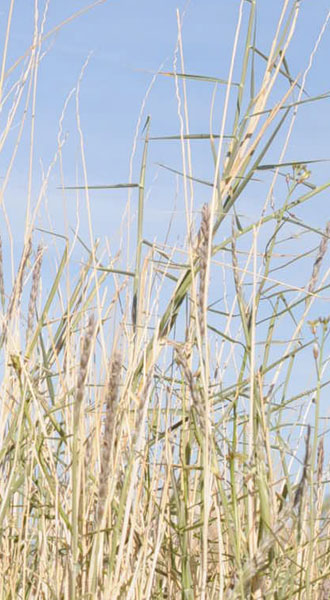
^Big galleta grass (Pleuraphis rigida).

^June dried wildflowers and creosote seeding, on the project site.
^Creosotes capture windblown sand, building mounds (Photo by Tom Budlong).
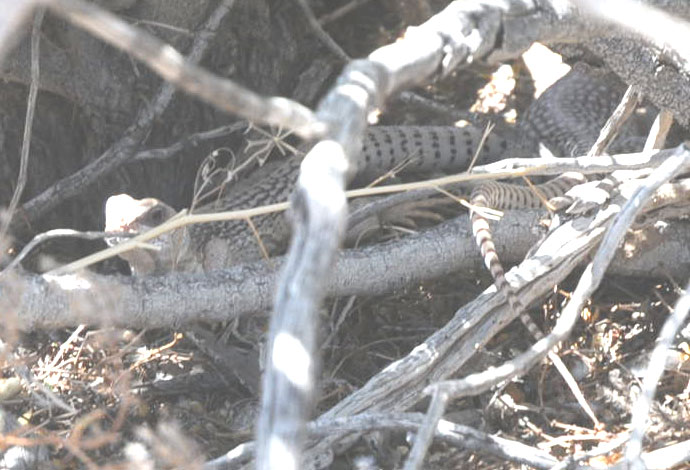
^A group of Desert iguanas (Dipsosaurus dorsalis) hang out in the shade of a creosote bush during the midday heat. June, 2010 on the project site.
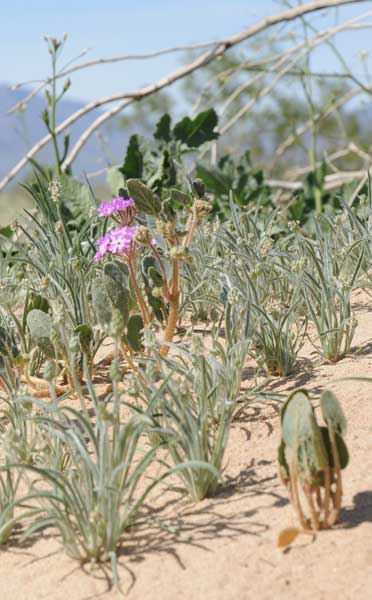
^March Plantain (Plantago ovata) and sand verbena.
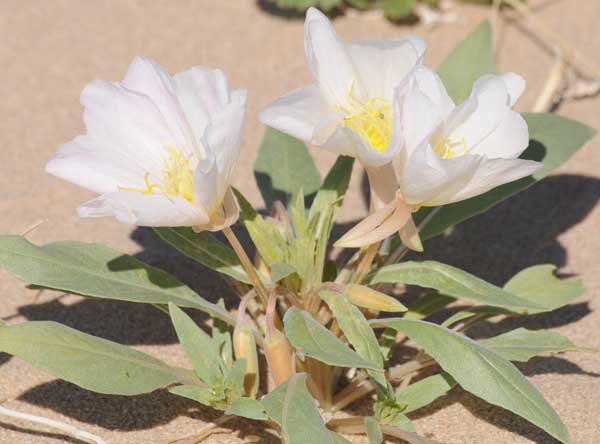
^Dune evening primrose (Oenothera deltoides) on sand.
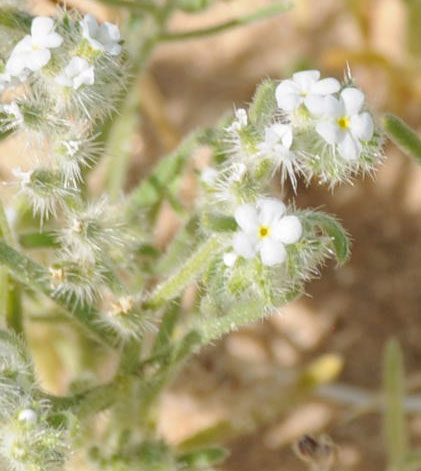
^Comb-bur (Pectocarya sp.) minute flowers in March.
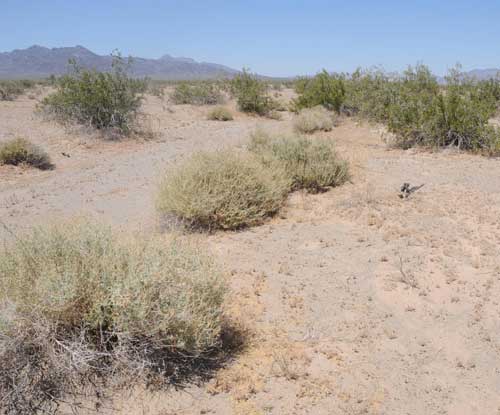
^Project site wash with Bursage (Ambrosia dumosa) and creosote.

^Wavy leaves of Desert lily and plantain tufts, March 2010, south of Ford Dry Lake.
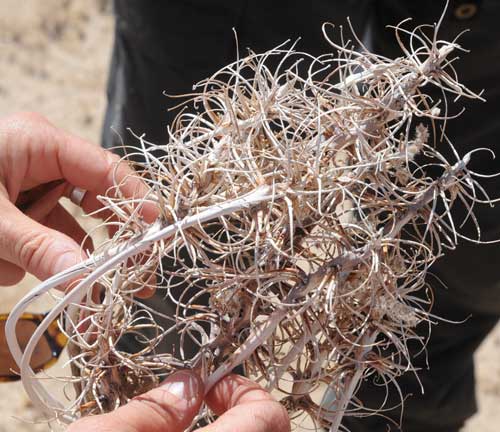
^"Bird-cage evening primrose" is another name for Dune evening primrose (Oenothera deltoides), as the dried-up stem breaks off and rolls about the desert.

^Kit fox (Vulpes macrotis) den.
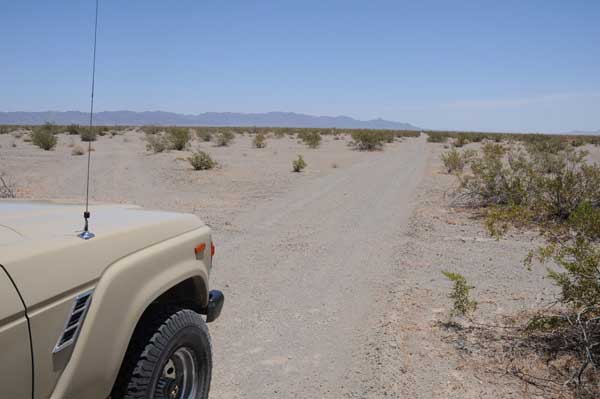
^We took the small dirt road through the project site north of Ford Dry Lake.
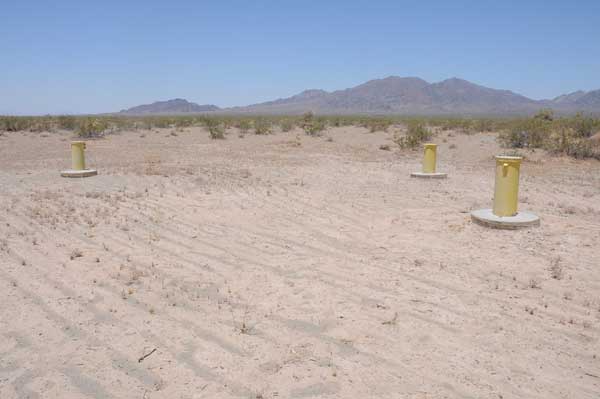
^Apparent recent test wells on the project site.
Fringe-toed Lizard Habitat and Dunes
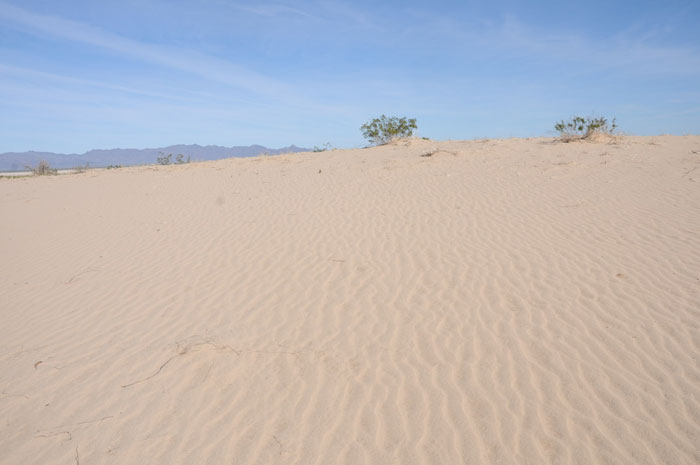
Sand stretches along the southern side of Ford Dry Lake, and is good habitat for Mojave fringe-toed lizards (Uma scoparia). On March 16, 2010, we saw numerous fringe-toed lizards here, at least 15 juveniles and adults out at 3 PM in an air temperature of 82 degrees Fahrenheit. Many ran into rodent burrows. We also saw this species on habitat that was not typical, on flat ground with hard surface, light gravel, and some loose silt and sand. Vegetation consisted of creosote, desert lily, sand verbena, plantain, and Sahara mustard.
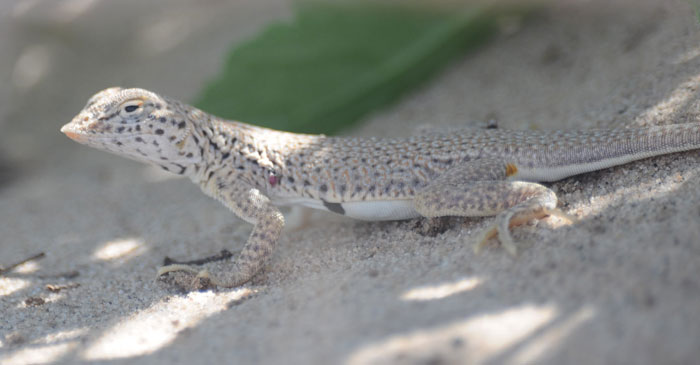
^Mojave fringe-toed lizard (Uma scoparia) at Ford Dry Lake south of the Genesis project site.
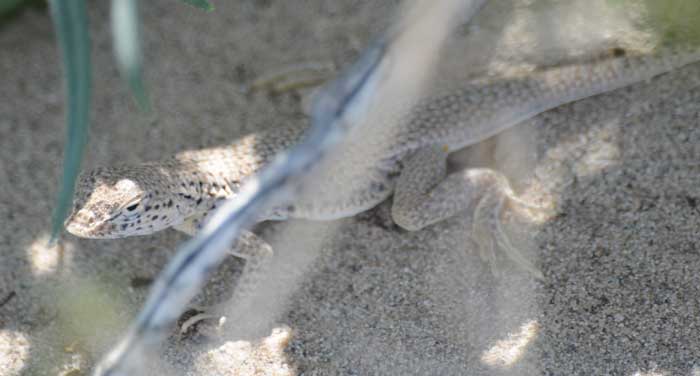
^Fringe-toed lizard seeking cover under a creosote shrub.
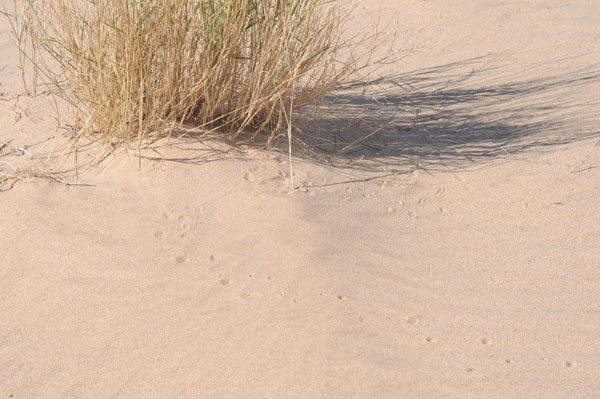
^"Pogo" mark tracks are characteristic of fringe-toed lizards as they dash through the sand.

^We saw numerous fringe-toed lizards in the habitat in March 2010, a hard-packed flat just south of Ford Dry Lake. The green ground cover is plantain. This is not usually considered habitat for this species.
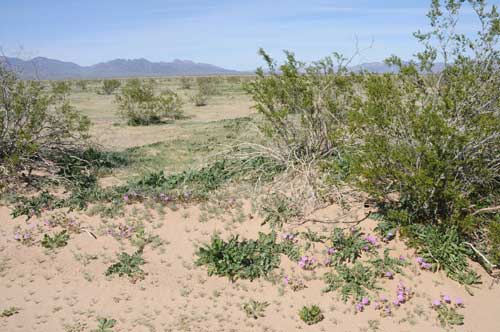
^Fringe-toed lizard habitat with sandy patches and verbena flowers, as well as gravel-silt creosote flats.
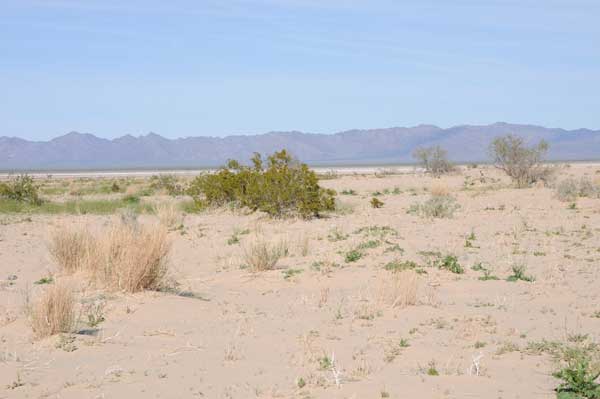
^Active blowing dunes were also habitat for fringe-toed lizards. Vegetation is of creosote, galleta grass, ironwood, and some introduced Sahara mustard. Ford Dry Lake lies in the distance, and the Genesis solar project site beyond that. The McCoy Mountains frame the background.
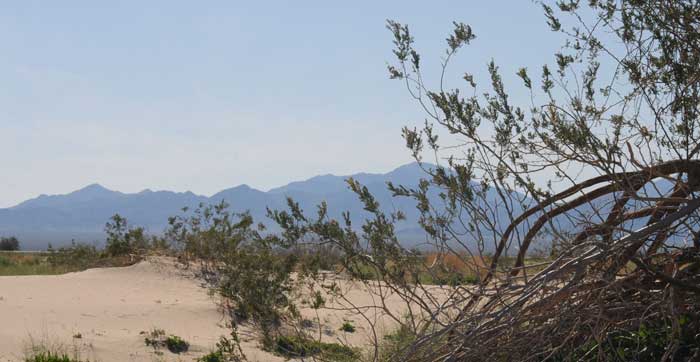
^Ironwood in sand dunes.
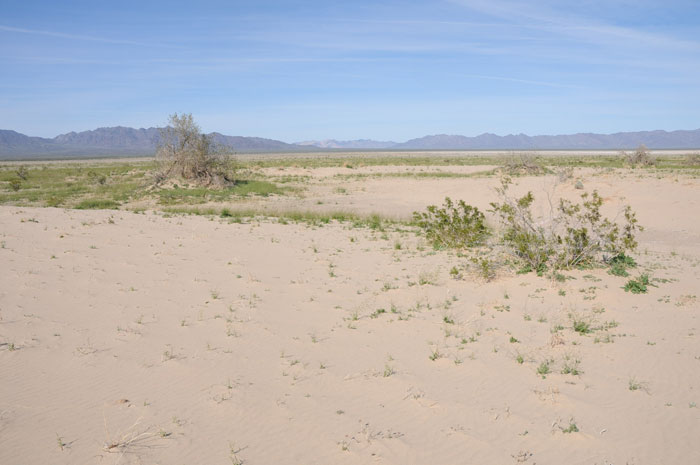
^Sand patches. The Palen Mountains lie to the left and McCoy Mountains to the right.
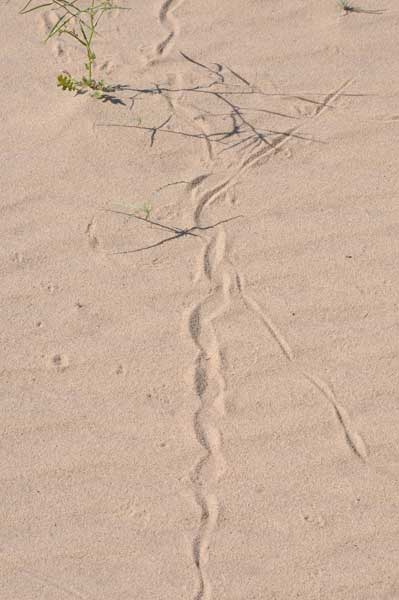
^The sandy areas show tracks of the nocturnal Western shovel-nosed snake (Chionactis occipitalis), which "swims" through the sand.

^Hummocky creosote flats below the Palen Mountains.
Wet-cooled Concentrated Solar Power Projects
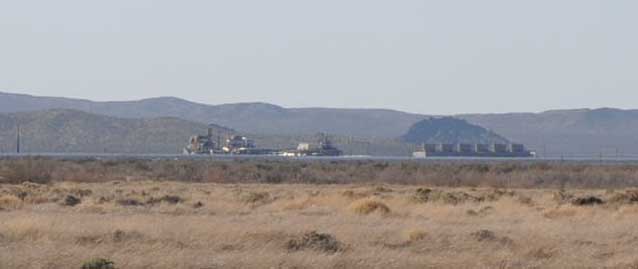
^The Harper Lake wet-cooled solar thermal power plants. Cooling towers lie to the right, the power block on the left. Luz built the Solar Electric Generating System (SEGS) plants VIII and IX in 1989 and 1990, respectively, then went bankrupt. SEGS VIII and IX are each 80 MW. These plants pump groundwater to cool the power block, but this type of use is unsustainable in the desert. Harper Lake basin is so over-drawn it is in adjudication.
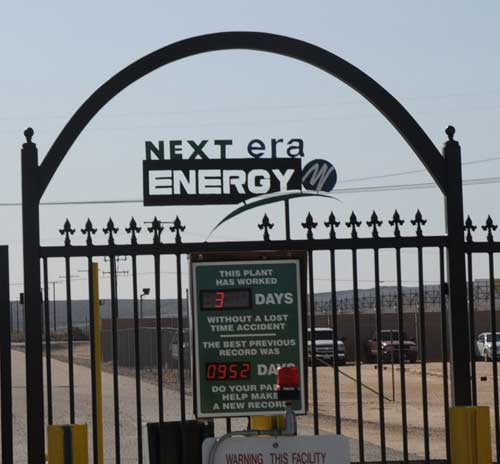
^Entrance gate at Harper Lake. NextEra bought these SEGS plants, the same company that is applying for an application to construct the Genesis Solar Energy Project.
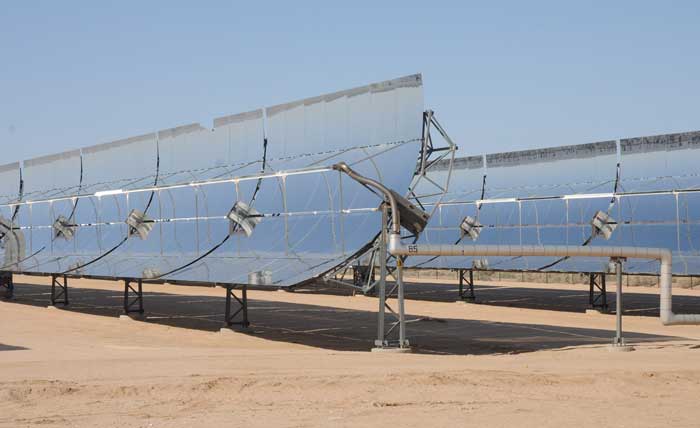
^Mirrors at Harper Lake.
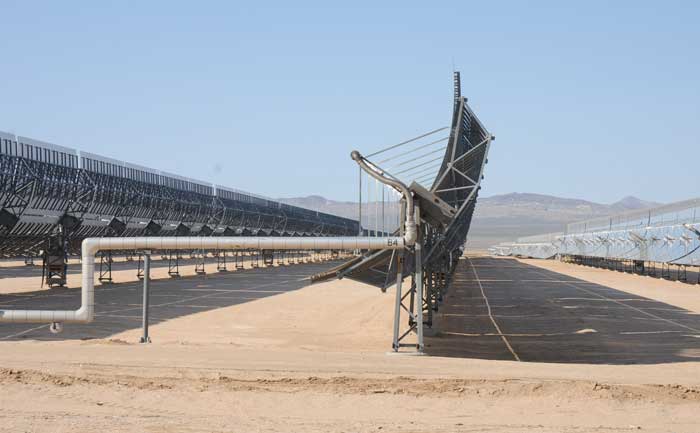
^Parabolic trough mirrors aiming at the sun. Heat Transfer Fluid (HTF), often a synthetic oil such as Therminol brand, is fed through pipes into the absorber tubes along the mirrors. These pipe joints are where HTF leaks often occur.
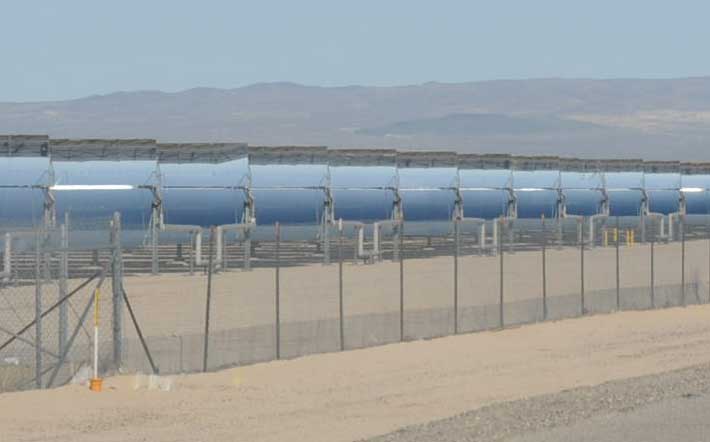
^Solar field at Harper Lake facility. The white-hot glowing absorber tubes can be seen taking up reflected heat from the mirrors. The absorber tubes contain Heat Transfer Fluid oil. Note the tortoise exclusion fence along the lower ground level of the chain-link fence.

^Steam dissipates into the desert air from the wet-cooling towers at the Nevada Solar One CSP plant in the Boulder City "green zone" in southern Nevada. This plant uses water from Lake Mead.
